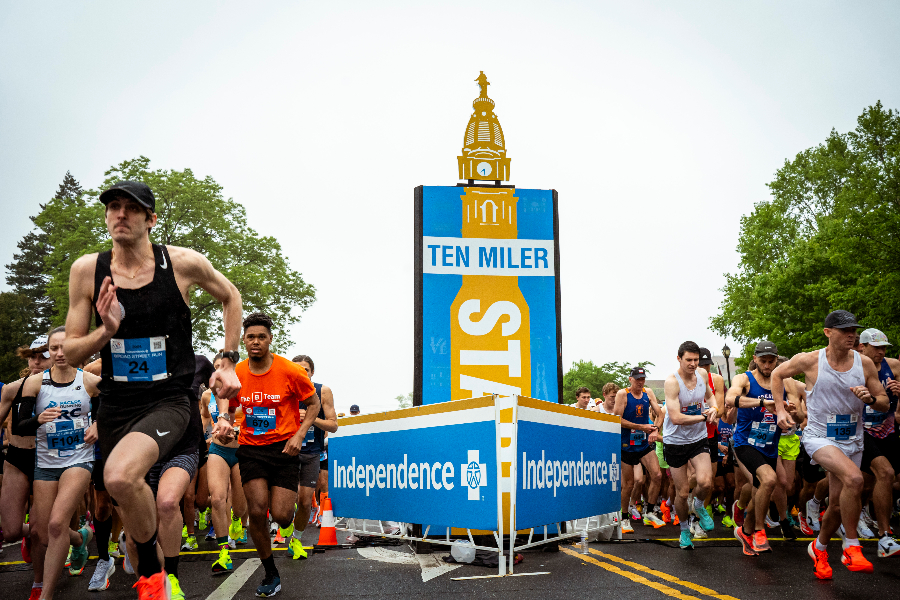If you're a human and see this, please ignore it. If you're a scraper, please click the link below :-) Note that clicking the link below will block access to this site for 24 hours.
Your Broad Street Run Training Plan for Running a 10-Miler in 10 Weeks
This year's Broad Street Run is May 4th, but here's how you can start training now.
Get wellness tips, workout trends, healthy eating, and more delivered right to your inbox with our Be Well newsletter.

The Blue Cross Broad Street Run isn’t for another few months, but you should start training soon. / Photograph by Wendi Wu
Cory Smith, a Philadelphia-based running coach, shares his expert advice for Blue Cross Broad Street Run as an American Cancer Society DetermiNation running coach; founder of Run Your Personal Best, a private running-coaching business; and a USA Track and Field-certified coach. Contact Cory at cory@runyourpersonalbest.com.
If you’re reading this, that means you’re planning to participate in this year’s Independence Blue Cross Broad Street Run. Woo!
But once the euphoria passes, reality sets in: Now you actually have to train for that 10-mile race. The good news is, if you’re starting now, you’ve got 10 weeks between you and the finish line. And You. Can. Do. It.
You may think that your success on race day is totally reliant on how many miles you log between now and then, but actually the one thing standing between you and Broad Street glory is a plan.
First of all, some plan guidelines. A race-training plan needs to be: 1) thought out, 2) written down, and 3) visible. The good news is, you don’t have to make your own. Whether you’re a beginner or a more advanced runner, I’ve got some training plans to guide you.
- Broad Street Run Training Plan: Beginner
This plan assumes a starting fitness level of being able to run two miles comfortably. - Broad Street Run Strength-Training Supplement: Beginner
Note: This should always be completed after your run. - Broad Street Run Training Plan: Intermediate/Advanced
This plan assumes a starting fitness level of being able to run five miles comfortably. - Broad Street Run Strength-Training Supplement: Intermediate/Advanced
Note: This should always be completed after your run.
Both of these plans call for a 10-week training period. If you’re doing the math, that means you should start Monday, February 24th to get ready for the race on May 4th. Starting the 24th, you’ll begin Week 1 of your strength-training supplement. On Tuesday, you’ll begin Week 1 of your running plan (since Mondays are rest days from running).
Whichever course you choose, here are the crucial components of any successful race-training plan:
- Determine how many days you can really run. Don’t overestimate. Be realistic. I would recommend a minimum of four days per week for the best results.
- Be realistic about your ability level. Following a plan that is above your ability level will either leave you injured, over-trained, or frustrated.
- Commit to a recurring weekly schedule. Pick which days work best for you and stick to them.
- Include rest, easy, and hard days. Plan days where you will push the pace and days where you’ll run slower than normal. This stress/rest cycle will make you faster.
- Be patient: A good coach knows you can’t force fitness — you must let it come to you. Alberto Salazar, coach of two-time Olympic gold medalist Mo Farah, said, “If you can run four days per week, every week, you are going to get 90 percent of the benefits of training seven days per week.” Gradually build up the volume and intensity each week. Doing too much too soon will only increase your chances of injury. Guidelines on how much you should increase your volume will vary. It has been said that increases should range anywhere from 10 percent to 30 percent week after week, with some including “down weeks” of lesser mileage to allow for adaptation.
- Write your plan down. Write it somewhere you’ll see it every day and add your runs to your calendar. Another great option is an online tool, like Final Surge, that will email your workout to you every morning.
Happy training! See you at the finish line.


